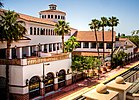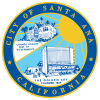
A | B | C | D | E | F | G | H | CH | I | J | K | L | M | N | O | P | Q | R | S | T | U | V | W | X | Y | Z | 0 | 1 | 2 | 3 | 4 | 5 | 6 | 7 | 8 | 9
Santa Ana, California | |
|---|---|
|
Top: Santora Building (left) and Santa Ana Regional Transportation Center (right); middle: Santa Ana City Hall (left), West Coast Theatre (center), and high rises (right); bottom: Bowers Museum (left) and Old Santa Ana Courthouse. | |
| Motto: Education First | |
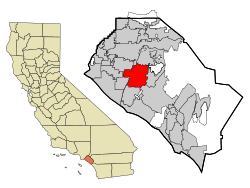 Location of Santa Ana within Orange County, California | |
Location in the Los Angeles Metropolitan Area Location in California | |
| Coordinates: 33°44′27″N 117°52′53″W / 33.74083°N 117.88139°W | |
| Country | United States |
| State | California |
| County | Orange |
| Founded | 1869[1] |
| Incorporated | June 1, 1886[2] |
| Named for | Saint Anne |
| Government | |
| • Mayor | Valerie Amezcua[3] |
| • Mayor pro tem | Jessie Lopez |
| • City council | Thai Viet Phan Benjamin Vazquez Phil Bacerra Johnathan Ryan Hernandez David Penaloza |
| • City manager | Kristine Ridge |
| Area | |
| • Total | 27.37 sq mi (70.89 km2) |
| • Land | 27.34 sq mi (70.81 km2) |
| • Water | 0.03 sq mi (0.08 km2) 0.90% |
| Elevation | 115 ft (35 m) |
| Population | |
| • Total | 306,457 |
| • Rank | 2nd in Orange County 13th in California 64th in the United States |
| • Density | 11,000/sq mi (4,300/km2) |
| Demonyms |
|
| Time zone | UTC−8 (Pacific) |
| • Summer (DST) | UTC−7 (PDT) |
| ZIP Codes[7] | 92701–92708, 92711, 92712, 92728, 92735, 92799 |
| Area code | 657/714, 949 |
| FIPS code | 06-69000 |
| GNIS feature IDs | 1652790,[5]2411814 |
| Website | santa-ana.org |
Santa Ana (Spanish for 'Saint Anne') is a city in and the county seat of Orange County, California, United States. Located in the Greater Los Angeles region of Southern California, the city's population was 310,227 at the 2020 census, making Santa Ana the second most populous city in Orange County (after Anaheim), the 13th-most populous city in California, and the 64th densest large city in the United States. Santa Ana is a major regional economic and cultural hub for the Orange Coast.
In 1810, the Spanish governor of California granted Rancho Santiago de Santa Ana to José Antonio Yorba. Following the Mexican War of Independence, the Yorba family rancho was enlarged, becoming one of the largest and most valuable in the region and home to a diverse Californio community. Following the American Conquest of California, the rancho was sold to the Sepúlveda family, who subsequently lost their land claim. In 1869, William H. Spurgeon then purchased the rancho and formally founded the modern city of Santa Ana.
Approximately four-fifths Hispanic or Latino, Santa Ana has been characterized by The New York Times as the "face of a new California, a state where Latinos have more influence in everyday life—electorally, culturally and demographically—than almost anywhere else in the country."[8]
History
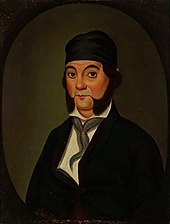
Members of the Tongva and Juaneño/Luiseño are indigenous to the area. The Tongva called the Santa Ana area "Hotuuk."[9][10] The village of Pajbenga was located at modern day Santa Ana along the Santa Ana River.[11][12]
Spanish and Mexican eras

After the 1769 expedition of Gaspar de Portolá out of Mexico City, then capital of New Spain, Friar Junípero Serra named the area Vallejo de Santa Ana (Valley of Saint Anne, or Santa Ana Valley). On November 1, 1776, Mission San Juan Capistrano was established within this valley.
In 1810, the first year of the Mexican War of Independence, Jose Antonio Yorba, a sergeant of the Spanish army, was granted land that he called Rancho Santiago de Santa Ana. Yorba's rancho included the lands where the cities of Olive, Orange, Irvine, Yorba Linda, Villa Park, Santa Ana, Tustin, Costa Mesa and unincorporated El Modena, and Santa Ana Heights, are today. This rancho was the only land grant in Orange County granted under Spanish Rule. Surrounding land grants in Orange County were granted after Mexican Independence by the new government.
After the Mexican-American War ended in 1848, Alta California became part of the United States and American settlers arrived in this area.[13]
Post-Conquest era
Santa Ana was listed as a township of Los Angeles County in the 1860 and 1870 census, with an area encompassing most of what is now northern and central Orange County. It had a population of 756 in 1860 and 880 in 1870. The Anaheim district was enumerated separately from Santa Ana in 1870.[14][15]
Claimed in 1869 by Kentuckian William H. Spurgeon on land obtained from the descendants of Jose Antonio Yorba, Santa Ana was incorporated as a city in 1886 with a population of 2000 and in 1889 became the seat of the newly formed Orange County.
In 1877, the Southern Pacific Railroad built a branch line from Los Angeles to Santa Ana, which offered free right of way, land for a depot, and $10,000 in cash to the railroad in exchange for terminating the line in Santa Ana and not neighboring Tustin. In 1887, the California Central Railway (which became a subsidiary of the Atchison, Topeka and Santa Fe Railway the following year) broke the Southern Pacific's local monopoly on rail travel, offering service between Los Angeles and San Diego by way of Santa Ana as a major intermediate station.
In 1890, whites made up 71 percent of the city's population, most of whom migrated to Santa Ana from confederate states following the American Civil War in search of real estate ventures and other economic opportunities.[16]
20th century


By 1905, the Los Angeles Interurban Railway, a predecessor to the Pacific Electric Railway, extended from Los Angeles to Santa Ana, running along Fourth Street downtown.[17] Firestone Boulevard, the first direct automobile route between Los Angeles and Santa Ana, opened in 1935; it was enlarged into the Santa Ana Freeway in 1953.[18] The Pacific Electric Santa Ana Line ran from 1905 to 1958.
Santa Ana was the home of the original Glenn L. Martin aviation company, founded in 1912 before merging with the Wright Company in 1916. Later, Glenn Luther Martin created a second company of the same name in Cleveland, Ohio which eventually merged with the Lockheed Corporation to form the largest defense contractor in the world, Lockheed Martin.[19]
Although there was a significant wave of Mexican migration to the city following the 1910 Mexican Revolution, the city remained majority white in 1939.[16]
During World War II, the Santa Ana Army Air Base was built as a training center for the United States Army Air Forces. The base was responsible for continued population growth in Santa Ana and the rest of Orange County as many veterans moved to the area to raise families after the end of the war.[20][21]
Santa Ana was at the center of Orange County's economic boom in the 1950s with its agricultural and defense industries. However, most of this prosperity was only experienced by the city's white residents, while Latinos did not similarly benefit. Instead, economic inequality between the two groups rapidly increased during this time.[16]
In 1958, the Honer Plaza and Bullock's Fashion Square malls opened and would supplant Downtown Santa Ana, with its department stores such as Rankin's, Ward's, Penney's and Buffums. Fashion Square was completely renovated and became MainPlace Mall in 1987.
Latino city

By the 1970s, Santa Ana was becoming an increasingly Latino city, with white flight to surrounding suburbs coinciding with the city's downtown becoming increasingly frequented by Latinos. This changed perceptions of the city and its economic value, with property values dropping significantly by 1974, while surrounding cities of Laguna Beach, Newport Beach, and Villa Park increased in value.[16]
Santa Ana entered the 1980s as a city of equal numbers of whites and Latinos. What had been the white commercial center of the city, Fourth Street, was now a street of Latino businesses and character. Latino immigrant and working-class families could now be found in every neighborhood of the city, rather than in just a few ethnic enclaves, as they were previously. Santa Ana became more often referred to as Santana and Fourth Street as La Cuatro.[16]
Having been a charter city since November 11, 1952, the citizens of Santa Ana amended the charter in November 1988 to provide for the direct election of the Mayor who until that point had been appointed from the council membership. Miguel A. Pulido was the first mayor of Latino descent in the city's history and the first Mayor directly elected by the voters.[22]
Since the 1980s, Santa Ana has been characterized by an effort to revitalize the downtown area which had declined in influence, even as it had become a dynamic commercial and entertainment center for working-class Latinos. The Santa Ana Artist's Village was created around Cal State Fullerton's Grand Central Art Center to attract artists and young professionals to live-work lofts and new businesses. The process continued into 2009 with the reopening of the historic Yost Theater.[23]

In the 2010s, gentrification became a larger concern of Santa Ana residents, with its roots starting in the 1990s. Despite strong Latino political representation, gentrification efforts have increasingly displaced the Mexican immigrant presence in the downtown area of the city in favor of outsiders. Primarily Spanish-speaking businesses that served immigrant populations have been demolished in favor of arts projects to draw in outside investment, which bring clientele who further question why Spanish-speaking businesses are present, leading to a cycle of displacement.[24]
Residents formed a social movement to address lead concentrations in lower-income areas of the city. A 2020 study found that areas of Santa Ana with a median income below $50,000 had five times higher lead concentrations than higher-income areas of the city, which is particularly a concern for children.[25] Residents continue to advocate for environmental justice in the city.[26]
Geography

Santa Ana is located at 33°44′27″N 117°52′53″W / 33.74083°N 117.88139°W (33.740717, -117.881408).[27]
According to the United States Census Bureau, the city has a total area of 27.5 square miles (71 km2). 27.3 square miles (71 km2) of it is land and 0.2 square miles (0.52 km2) of it (0.90%) is water. With 12,471.5 people per sq. mile, it is the fourth-most densely populated city in the United States with a population of 300,000 or more.[28]
Santa Ana is nested on flat, low-lying plains with little land elevation change. Running through the west end of the city is the mostly channelized Santa Ana River, which is also largely seasonal due to the construction of the Prado Dam and Seven Oaks Dam. The river has caused several severe floods in the 20th century, and is a continued threat despite the existence of the dams.
Cityscape
Now fully developed, Santa Ana has several distinct districts. The core of the city is the downtown area, which contains both retail and housing, as well as the Santa Ana Civic Center, which is a dense campus of administrative buildings for both the city and the county of Orange. The civic center is also home to the Ronald Reagan Federal Building and Courthouse. Several historic homes dating from the late 1800s can be found as well, and their preservation is a key issue as development of the downtown area continues.[29]
North of downtown is the "Midtown" district along Main St., home to entertainment destinations such as the Bowers Museum, MainPlace Mall, and the Discovery Science Center.
Near the intersection of the Santa Ana Freeway and the Costa Mesa Freeway is the newly designated "Metro East" area, which the city council has envisioned as a secondary mixed-use development district.[30] Currently the area is occupied by several office towers, but little retail or housing. Also on the east side of the city is the Santa Ana Zoo, notable for its collection of monkeys and species from South and Central America.
The southeast end of the city is part of the South Coast Metro area, which is shared with the city of Costa Mesa. South Coast Plaza, a major shopping center, is the primary destination of this area, which also contains several high-rise office and apartment buildings. Yokohama Tire Corporation's United States headquarters are located at 1 MacArthur Place in the South Coast Metro area of Santa Ana, and Banc of California's headquarters relocated from the neighboring city of Irvine.[31][32]
Climate
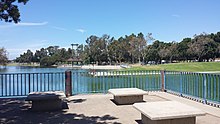
Santa Ana experiences a hot semi-arid climate (Köppen: BSh), with hot, dry summers and mild winters with moderate rainfall.[33] Rainfall averages about 12.54 in (318.5 mm) per year, most of which falls from November through April. There are an average of 35 days with measurable precipitation annually.[34]
The record high temperature for Santa Ana was 112 °F (44 °C) on June 14, 1917.[35] The record low temperature was 16 °F (−9 °C) on January 12, 1989.[35] There are an average of 30.1 days with highs of 90 °F (32 °C) or higher.[34]
The wettest "rain year" in Santa Ana was from July 1940 to June 1941 with 34.34 inches (872.2 mm), and the driest was from July 2017 to June 2018 with a mere 2.73 inches (69.3 mm).[35] The most rainfall in one month was 13.99 inches (355.3 mm) in February 1998.[35] The most rainfall in 24 hours was 4.69 inches (119.1 mm) on February 16, 1927.[35]
| Climate data for Santa Ana, California (normals 1991–2020, extremes 1916–present) | |||||||||||||
|---|---|---|---|---|---|---|---|---|---|---|---|---|---|
| Month | Jan | Feb | Mar | Apr | May | Jun | Jul | Aug | Sep | Oct | Nov | Dec | Year |
| Record high °F (°C) | 96 (36) |
95 (35) |
98 (37) |
104 (40) |
105 (41) |
112 (44) |
110 (43) |
106 (41) |
111 (44) |
106 (41) |
101 (38) |
95 (35) |
112 (44) |
| Mean maximum °F (°C) | 84.6 (29.2) |
85.0 (29.4) |
86.5 (30.3) |
90.8 (32.7) |
89.7 (32.1) |
90.1 (32.3) |
93.0 (33.9) |
96.1 (35.6) |
99.6 (37.6) |
96.0 (35.6) |
89.8 (32.1) |
81.3 (27.4) |
101.6 (38.7) |
| Mean daily maximum °F (°C) | 69.3 (20.7) |
69.3 (20.7) |
71.2 (21.8) |
73.2 (22.9) |
74.7 (23.7) |
77.7 (25.4) |
82.5 (28.1) |
84.6 (29.2) |
83.8 (28.8) |
79.4 (26.3) |
74.0 (23.3) |
68.4 (20.2) |
75.7 (24.3) |
| Daily mean °F (°C) | 59.0 (15.0) |
59.4 (15.2) |
61.5 (16.4) |
63.7 (17.6) |
66.4 (19.1) |
69.5 (20.8) |
73.6 (23.1) |
75.0 (23.9) |
73.8 (23.2) |
69.4 (20.8) |
63.4 (17.4) |
58.2 (14.6) |
66.1 (18.9) |
| Mean daily minimum °F (°C) | 48.7 (9.3) |
49.5 (9.7) |
51.8 (11.0) |
54.2 (12.3) |
58.1 (14.5) |
61.3 (16.3) |
64.7 (18.2) |
65.3 (18.5) |
63.9 (17.7) |
59.4 (15.2) |
52.8 (11.6) |
48.1 (8.9) |
56.5 (13.6) |
| Mean minimum °F (°C) | 39.5 (4.2) |
40.7 (4.8) |
42.8 (6.0) |
46.0 (7.8) |
51.5 (10.8) |
55.2 (12.9) |
59.2 (15.1) |
59.7 (15.4) |
57.2 (14.0) |
53.5 (11.9) |
43.6 (6.4) |
38.5 (3.6) |
36.7 (2.6) |
| Record low °F (°C) | 16 (−9) |
22 (−6) |
28 (−2) |
31 (−1) |
35 (2) |
39 (4) |
42 (6) |
45 (7) |
40 (4) |
34 (1) |
24 (−4) |
22 (−6) |
16 (−9) |
| Average precipitation inches (mm) | 2.88 (73) |
3.16 (80) |
1.71 (43) |
0.82 (21) |
0.29 (7.4) |
0.08 (2.0) |
0.03 (0.76) |
0.00 (0.00) |
0.12 (3.0) |
0.50 (13) |
0.79 (20) |
2.16 (55) |
12.54 (319) |
| Average precipitation days (≥ 0.01 in.) | 6.3 | 6.6 | 4.9 | 2.9 | 1.7 | 0.6 | 0.5 | 0.1 | 0.6 | 2.1 | 2.8 | 5.9 | 35.0 |
| Source: NOAA[35][34] | |||||||||||||
Demographics
The most common Hispanic ancestries in Santa Ana are Mexican, Salvadorian and Guatemalan. The most common European ancestries are German, Irish, English and Italian.[36] By the late 1970s, African-American families began to move out of Santa Ana.[20]
| Census | Pop. | Note | %± |
|---|---|---|---|
| 1880 | 711 | — | |
| 1890 | 3,628 | 410.3% | |
| 1900 | 4,933 | 36.0% | |
| 1910 | 8,429 | 70.9% | |
| 1920 | 15,485 | 83.7% | |
| 1930 | 30,322 | 95.8% | |
| 1940 | 31,921 | 5.3% | |
| 1950 | 45,533 | 42.6% | |
| 1960 | 100,350 | 120.4% | |
| 1970 | 155,710 | 55.2% | |
| 1980 | 204,023 | 31.0% | |
| 1990 | 293,742 | 44.0% | |
| 2000 | 337,977 | 15.1% | |
| 2010 | 324,528 | −4.0% | |
| 2020 | 310,227 | −4.4% | |
| 2023 (est.) | 299,630 | [37] | −3.4% |
| U.S. Decennial Census[38] 2010[39] 2020[40] | |||
2020
The 2020 United States Census[41] reported that Santa Ana had a population of 310,227. The racial makeup of Santa Ana was 8.5% Non-Hispanic White, 1.1% African American, 3.7% Native American, 12.3% Asian, 0.3% Pacific islander, 45.1% Other, 19.1% two or more races, and 76.7% Hispanic or Latino.
| Race / Ethnicity (NH = Non-Hispanic) | Pop 2000[42] | Pop 2010[39] | Pop 2020[40] | % 2000 | % 2010 | % 2020 |
|---|---|---|---|---|---|---|
| White alone (NH) | 41,984 | 29,950 | 26,428 | 12.42% | 9.23% | 8.52% |
| Black or African American alone (NH) | 4,309 | 3,177 | 2,745 | 1.27% | 0.98% | 0.88% |
| Native American or Alaska Native alone (NH) | 886 | 507 | 485 | 0.26% | 0.16% | 0.16% |
| Asian alone (NH) | 29,412 | 33,618 | 37,440 | 8.70% | 10.36% | 12.07% |
| Pacific Islander alone (NH) | 993 | 826 | 635 | 0.29% | 0.25% | 0.20% |
| Other race alone (NH) | 273 | 375 | 921 | 0.08% | 0.12% | 0.30% |
| Mixed race or Multiracial (NH) | 3,023 | 2,147 | 3,541 | 0.89% | 0.66% | 1.14% |
| Hispanic or Latino (any race) | 257,097 | 253,928 | 238,022 | 76.07% | 78.25% | 76.73% |
| Total | 337,977 | 324,528 | 310,227 | 100.00% | 100.00% | 100.00% |
2010
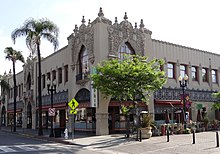
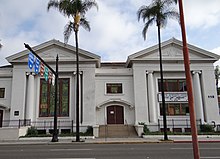
The 2010 United States Census[43] reported that Santa Ana had a population of 324,528. The population density was 11,793.3 inhabitants per square mile (4,553.4/km2). The racial makeup of Santa Ana was 148,838 (45.9%) White (9.2% Non-Hispanic White), 4,856 (1.5%) African American, 3,260 (1.0%) Native American, 34,138 (10.5%) Asian, 976 (0.3%) Pacific Islander, 120,789 (37.2%) from other races, and 11,671 (3.6%) from two or more races. Hispanic or Latino people of any race were 253,928 persons (78.2%).
The census reported that 319,870 people (98.6% of the population) lived in households, 1,415 (0.4%) lived in non-institutionalized group quarters, and 3,243 (1.0%) were institutionalized.
There were 73,174 households, out of which 41,181 (56.3%) had children under the age of 18 living in them, 41,389 (56.6%) were opposite-sex married couples living together, 11,808 (16.1%) had a female householder with no husband present, 6,451 (8.8%) had a male householder with no wife present. There were 4,933 (6.7%) unmarried opposite-sex partnerships, and 556 (0.8%) same-sex married couples or partnerships. 9,254 households (12.6%) were made up of individuals, and 3,378 (4.6%) had someone living alone who was 65 years of age or older. The average household size was 4.37. There were 59,648 families (81.5% of all households); the average family size was 4.54.
The age distribution of the population was as follows: 99,678 people (30.7%) under the age of 18, 39,165 people (12.1%) aged 18 to 24, 102,399 people (31.6%) aged 25 to 44, 61,375 people (18.9%) aged 45 to 64, and 21,911 people (6.8%) who were 65 years of age or older. The median age was 29.1 years. For every 100 females, there were 104.4 males. For every 100 females age 18 and over, there were 104.6 males.
There were 76,896 dwelling units at an average density of 2,794.4 per square mile (1,078.9/km2), of which 34,756 (47.5%) were owner-occupied, and 38,418 (52.5%) were occupied by renters. The homeowner vacancy rate was 1.9%; the rental vacancy rate was 4.9%. 154,045 people (47.5% of the population) lived in owner-occupied dwelling units and 165,825 people (51.1%) lived in rental dwelling units.
During 2009–2013, Santa Ana had a median household income of $53,335, with 21.5% of the population living below the federal poverty line.[44]
2000


As of the census[45] of 2000, there were 337,977 people, 73,002 households, and 59,788 families residing in the city. The population density was 4,808.2/km2 (12,451.9/mi2). There were 74,588 housing units at an average density of 1,061.1/km2 (2,748.0/mi2). The racial makeup of the city was 42.73% White, 1.70% African American, 1.19% Native American, 8.81% Asian, 0.34% Pacific Islander, 40.64% from other races, and 4.58% from two or more races. 76.07% of the population were Hispanic or Latino of any race.
There were 73,002 households, out of which 53.2% had children under the age of 18 living with them, 60.6% were married couples living together, 13.5% had a female householder with no husband present, and 18.1% were non-families. 12.7% of all households were made up of individuals, and 4.6% had someone living alone who was 65 years of age or older. The average household size was 4.55 and the average family size was 4.72.
In the city, the population was spread out, with 34.2% under the age of 18, 12.8% from 18 to 24, 34.1% from 25 to 44, 13.5% from 45 to 64, and 5.5% who were 65 years of age or older. The median age was 26 years. For every 100 females, there were 107.7 males. For every 100 females age 18 and over, there were 108.7 males.
The median income for a household from 2005 to 2009 was $54,521.[46] The median income for a household in the city was $43,412, and the median income for a family was $41,050. Males had a median income of $23,342 versus $21,637 for females. The per capita income for the city was $12,152. 19.8% of the population and 16.1% of families were below the poverty line. Out of the total population, 24.1% of those under the age of 18 and 10.4% of those 65 and older were living below the poverty line.
Economy
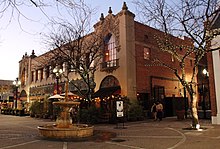

Santa Ana is the corporate headquarters of several companies, including Behr Paint, First American Corporation, Greenwood & Hall, Ingram Micro, SchoolsFirst Federal Credit Union, STEC, TTM Technologies, Kern's, and Wahoo's Fish Taco. It also houses major regional headquarters for the Xerox corporation, Ultimate Software, and T-Mobile. Nonprofits based in Santa Ana include Open Doors.
One of Santa Ana's most notable businesses is the Rickenbacker musical instrument company, whose electric guitars and bass guitars earned fame in the hands of many rock and roll legends.
Then Glenn L. Martin Company, a precursor to Lockheed Martin, was founded in Santa Ana in 1912 before merging with the Wright Company in 1916.
In recent years, the nearby city of Irvine has outpaced Santa Ana in commercial growth, with the Irvine Business District located near John Wayne Airport. To compete with this, Santa Ana has approved commercial projects in the South Coast Metro area, as well as the "Metro East" development, located at the confluence of the Santa Ana Freeway and the Costa Mesa Freeway.
The Historic South Main Business District contains many older retail shops and other small businesses. It extends from downtown Santa Ana southwards on Main Street to the South Coast Metro area.
There was a recession in the 2000s, and the expected year for return to peak employment for the Los Angeles-Long Beach-Santa Ana area was 2015. The pre-recession peak year was 2007. Due to the recession, 519,300 jobs were lost, a 9% decrease.[47] According to the Employment Development Department, the unemployment rate for 2015 was 5 percent.
Top employers

According to the city's 2021 Annual Comprehensive Financial Report,[48] the top employers in the city are:


